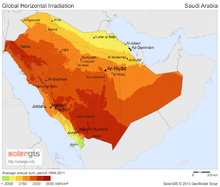
Solar power in Saudi Arabia has become more important to the country as oil prices have risen. Saudi Arabia is located in the Arabian Peninsula, where it receives 12 hours of sun a day.[1] Saudi Arabia has the potential to supply its electrical needs solely with solar power.[2] As the largest oil producer and exporter in the world and one of the largest carbon dioxide producers Saudi Arabia would set an important precedent in renewable energy by shifting to solar power.[3] In 2021, 60.89% of energy consumed was produced by burning oil.[4] The Saudi agency in charge of developing the nations renewable energy sector, Ka-care, announced in May 2012 that the nation would install 41 gigawatts (GW) of solar capacity by 2032.[5] It was projected to be composed of 25 GW of solar thermal, and 16 GW of photovoltaics. At the time of this announcement, Saudi Arabia had only 0.003 gigawatts of installed solar energy capacity.[6] A total of 54 GW was expected by 2032, and 24 GW was expected in 2020, which was never reached.[7] 1,100 megawatts (MW) of photovoltaics and 900 megawatts of concentrated solar thermal (CSP) was expected to be completed by early 2013.[8] Also in 2013, solar power in Saudi Arabia had achieved grid parity and was able to produce electricity at costs comparable to conventional sources.[9]
In March 2018 Saudi Arabia announced that together with Softbank they plan to install 200 GW of solar power through 2030.[10] This compares to a global solar power installation of 100 GW in 2017 and a total installed capacity of 77 GW in Saudi Arabia in 2016. This project was cancelled in September 2018.[11]
The National Renewable Energy Program (NREP), backed by the Public Investment Fund (PIF), outlines plans for 11.8 GW of renewable energy projects in collaboration with ACWA Power by 2025, subject to approval from the Ministry of Energy. This initiative aligns with the goal of generating 50% of electricity from renewable sources by 2030.[12]
- ^ "PIF: Funding New Human Futures". Retrieved 2024-11-14.
- ^ Cite error: The named reference
:0was invoked but never defined (see the help page). - ^ Rashwan, Sherif S.; Shaaban, Ahmed M.; Al-Suliman, Fahad (2017-12-01). "A comparative study of a small-scale solar PV power plant in Saudi Arabia". Renewable and Sustainable Energy Reviews. 80: 313–318. doi:10.1016/j.rser.2017.05.233. ISSN 1364-0321.
- ^ Share of energy consumption by source, Saudi Arabia
- ^ Louis Boisgibault, Fahad Al Kabbani (2020): Energy Transition in Metropolises, Rural Areas and Deserts. Wiley - ISTE. (Energy series) ISBN 9781786304995.
- ^ Wael Mahdi and Marc Roca. "Saudi Arabia Plans $109 Billion Boost for Solar Power." Bloomberg News. May 11, 2012 9:23 AM CT
- ^ Solar power export to Europe planned by KSA
- ^ Saudi Arabia Plan $109 Billion Solar Energy Project to Reduce Oil Consumption
- ^ Michael Deaves (February 27, 2013). "Solar Achieves Grid Parity in Saudi Arabia – Significant Developments Expected". ClearSky Advisors. Retrieved 2018-05-08.
- ^ Saudis, SoftBank Plan World's Largest Solar Project Bloomberg, 2018-03-28
- ^ Jones, Rory; Said, Summer (2018-09-30). "Saudi Arabia Shelves Work on SoftBank's $200 Billion Solar Project". Wall Street Journal. ISSN 0099-9660. Retrieved 2018-10-05.
- ^ "Saudi National Renewable Energy Program (NREP) – Policies". IEA. Retrieved 2024-03-20.